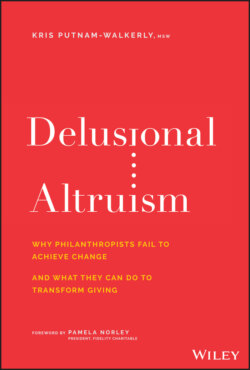Читать книгу Delusional Altruism - Kris Putnam-Walkerly - Страница 30
Fear of Loss
ОглавлениеIn my experience, philanthropists fear two kinds of loss. Loss of the person you thought you were and loss of control.
Fear of losing the person you thought you were goes along with the previously mentioned fear, the fear of learning you aren't right. But it goes deeper.
You might participate in a workshop about undoing implicit bias and learn you have more racial bias than you realized. A lot more. Turns out, you aren't the “colorblind” person you thought you were. You conclude that all this “racial equity” stuff you've been hearing about might just be too much for you to deal with. After all, it will require you and your philanthropy to change significantly. You fear losing the person you thought you were, and you decide it's easier to stay in denial, thank you very much.
I feared losing the person I thought I was during college. I decided to study abroad in Ecuador. I had always envisioned myself as someone who could join the Peace Corps, live in the global South (we called it the Third World back then), and help people in developing countries. After all, I had a double major in anthropology and political science and a double minor in Latin American studies and Spanish. What more could I need?
But there I was in rural Ecuador. I had gotten scabies after living with my gracious indigenous host family, sleeping on a woven mat on the dirt floor of their hut. I was slumped over a toilet throwing up uncontrollably, while simultaneously trying to down a bottle of Pepto Bismol. I couldn't stop itching. I was exhausted, homesick, and desperately missed American pizza.
In retrospect, my predicament makes me laugh. At the time, however, I deeply questioned myself. I wondered if I was really the person I thought I was. And I realized the answer was, “Not exactly.” The reality of living in a poor community in Ecuador was a heck of a lot different than imagining it from Bloomington, Indiana! I experienced a loss of the person I thought I was, and it was hard.
Philanthropists also fear the loss of power and control. There is a lot of power in philanthropy. There is the power to ignite social change by strategically using your philanthropic capital to advance your goals. And there is a lot of power simply being the person with access to wealth. This creates a power dynamic: The giver gives and the recipient receives. Guess who holds the power? With power comes control. Donors get to choose which causes they support, whom they fund, and what they expect will happen with those funds.
Here are some of the ways that funders, out of fear, try to hold on to power and control:
Not offering general operating support. General operating (also known as core support) is a grant in support of a nonprofit organization's mission rather than specific projects or programs. It provides the working capital nonprofits need to sustain their day-to-day operations, address changing needs, and take advantage of unforeseen opportunities. It's the type of funding most nonprofit leaders want, yet too few funders provide. David Callahan, founder and editor of Inside Philanthropy and author of The Givers, argues that many funders don't want to provide general operating support because they fear they will lose control when they let the nonprofit figure out the best way to use the grant. They would rather have control over the money by giving nonprofits clear objectives and goals and tracking their progress to make sure they are meeting their objectives.4
Not retaining outside expertise. Many wealth advisors and family offices could provide substantially more services to help their clients reach their philanthropic goals. And given the anticipated $68 trillion intergenerational transfer of wealth over the next several decades, providing philanthropy services is a great way to engage the next generation and retain clients across generations. If they don't have the expertise in-house (which most don't), they could retain or refer outside philanthropy experts to help them. But they have a misguided fear that if they involve others, they might lose the client or damage the client relationship. They fear losing control. Instead of helping their clients transform their giving (and increase the likelihood that they keep the next generation as clients), they continue providing minimal, subpar, and transactional philanthropy guidance.
Losing control of donor legacy. Loss of legacy is another fear, especially in family foundations or family businesses. When I worked at the David and Lucile Packard Foundation, new-employee orientation included watching a video about the foundation's history. We learned how Dave and his friend Bill Hewlett started Hewlett-Packard out of a garage, the reasons he and his wife Lucile began their foundation, and the values of their family. It was a terrific way to help preserve the legacy of the family and foundation among the hundreds of employees who would play important roles in the foundation over decades.Another donor, however, embraced a scarcity mentality when designing the legacy of his family foundation. A successful business leader, he was generous when it came to giving back to his community. In designing his board members' succession plan, however, he didn't just outline the role of family and nonfamily members on the board. He named specific people who would be asked to join the board if there was a vacancy, and in what order. And he put it in the foundation's bylaws.Fast-forward to today: The donor has passed away. Among the individuals he named, most have little awareness about or interest in the foundation, and many are retiring. I can appreciate that he wanted to ensure that his foundation would be stewarded by people he trusted. But his fear of losing control of donor legacy is preventing the current foundation leadership from developing the board they need to guide the foundation into the future.
